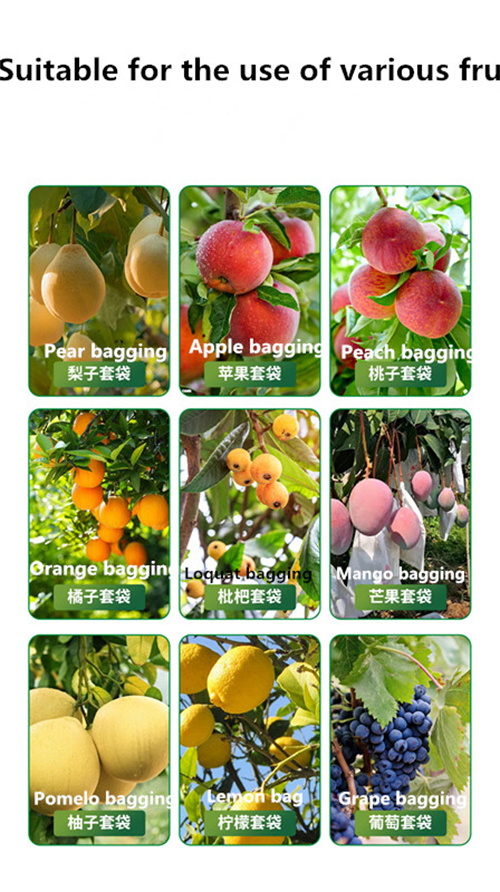Aug . 08, 2024 15:40 Back to list
Manufacturer of Fruit Bags Designed for Protecting Trees and Enhancing Growth for Optimal Harvests
Fruit Bags for Trees A Look into Their Importance and Manufacturing
As the demand for organic and pesticide-free fruits continues to rise, methods for protecting fruit trees from pests and diseases have become increasingly vital in the agricultural industry. One of the most effective solutions to this problem has been the use of fruit bags. These protective coverings not only safeguard fruits from insects, birds, and environmental factors but also enhance the overall quality of the produce. In this article, we will delve into the significance of fruit bags for trees and explore the nuances of their manufacturing process.
The Significance of Fruit Bags
Fruit bags serve several key purposes in the cultivation of fruit trees. Firstly, they provide physical protection for the fruit. By covering the developing fruits, these bags prevent various pests such as birds, insects, and even larger animals from accessing and damaging the fruit. This protection is especially important for fruits that are particularly vulnerable, such as apples, pears, and peaches.
Moreover, fruit bags help in minimizing the use of chemical pesticides. In the past, farmers relied heavily on chemical interventions to protect their crops. However, with growing concerns about pesticide residues and their effects on human health and the environment, fruit bags present a more sustainable alternative. They create a barrier that reduces the reliance on harmful chemicals, providing a safer option for both consumers and the ecosystem.
In addition to pest control, fruit bags also play a role in improving fruit quality. They can shield fruits from harsh weather conditions, including excessive sun exposure and rain. This protection can enhance the texture, color, and taste of the final product, leading to higher market values and consumer satisfaction.
The Manufacturing Process of Fruit Bags
The manufacturing of fruit bags involves several critical steps to ensure that the bags are both effective and environmentally friendly.
fruit bags for trees manufacturer

1. Material Selection The first step in manufacturing fruit bags is selecting the appropriate materials. Most fruit bags are made from lightweight, breathable materials such as non-woven fabric, mesh, or paper. These materials must allow for air and moisture circulation while still providing a barrier against pests and environmental conditions.
2. Design and Sizing The design of the fruit bags is also crucial. Manufacturers need to consider various factors like the size of the fruit, the specific types of trees, and the climatic conditions of the growing region. Bags need to be appropriately sized to accommodate the fruit’s growth while ensuring they remain snug and secure.
3. Production Techniques The production process typically involves cutting the chosen materials into the desired shapes and sizes, followed by sewing or sealing them. Modern manufacturing facilities may employ automated machinery to enhance efficiency and precision in the production process.
4. Quality Control After production, quality control measures are implemented to ensure that the fruit bags meet industry standards. Tests may be conducted to check for durability, breathability, and resistance to various environmental factors.
5. Eco-Friendly Practices As sustainability becomes a priority in agriculture, many manufacturers are exploring eco-friendly materials and processes. Biodegradable options are being developed to reduce the impact of plastic waste on the environment, aligning with the global push for sustainable practices.
Conclusion
Fruit bags for trees represent a blend of tradition and innovation in fruit cultivation. Their role in protecting fruit from pests, minimizing chemical use, and enhancing quality cannot be overstated. As the demand for organic produce continues to grow, so too will the advancements in the manufacturing processes behind fruit bags. In a world increasingly focused on sustainability, these protective covers are poised to play an essential role in the future of agriculture, ensuring that fruit cultivation is as green as it is fruitful.
-
Pollen Peach Tree for Pure Pollination and High-Quality Peach Pollen
NewsJul.30,2025
-
Premium Cherry Pollen for Pure Pollination & Different Types
NewsJul.30,2025
-
Artificial Pollination Solutions for Various Plant Pollen Types
NewsJul.29,2025
-
Artificial Pollination Solutions for All Plant Pollen Types
NewsJul.29,2025
-
Premium Plant Pollen for Pure Pollination & Pollen Block Solutions
NewsJul.29,2025
-
Artificial Pollination Solutions for Efficient Crop Yields
NewsJul.28,2025